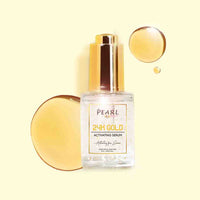Manjistha is popularly known for its medicinal properties and vibrant red color that has therapeutic properties. It is also used in dyes and textiles. People often think Manjistha is only for skin whitening but overlook its other advantages. Manjistha's benefits and properties are to be learned to know how beneficial it can be for our skin health. Our ARM Pearl Glowing Night Cream is one of the best anti-wrinkle and tan removal creams, powered by Manjistha extract. Below, we will learn the history of Manjistha, its therapeutic and ayurvedic benefits and its DIY recipes.

What is the History of Manjistha?
Manjistha is a medicinal herb that has traces back to ancient civilizations of India. Popular ayurvedic texts such as Charaka Samhitha and Sushritha Samhitha have documented Manjistha long back, around 500 BCE to 1000 BCE. It has many blood-purifying and detoxifying properties, which makes it very helpful in maintaining radiant skin. Back then, it was used in many powders and decoctions to help fight skin diseases and infections from irregular menstruation.
By the 1500s, Manjistha had become a popular item along the spice routes, valued for its health advantages and its role in making dyes. This helped it become a part of different cultures across Asia and Europe. Manjistha was known and used beyond its local area in the old days, making its way into Persian and Arabic health practices. It was appreciated for its ability to help with liver problems and to enhance blood flow.
What are the Therapeutic Powers of Manjistha?
Manjistha's popularity is built around its extensive therapeutic benefits since ancient times. The herb contains anthraquinones, like purpurin and munjistin, which can reduce inflammation and fight off microbes. Manjistha is crucial in treating skin diseases such as eczema, psoriasis, and acne. Furthermore, its Lymphatic stimulant properties help in blood purification and toxins removal from the body, which in turn helps maintain skin and immune system.

Regarding how much to take, traditional experts often suggest using 1 to 3 grams of dried root powder daily, but this amount can change depending on a person's specific health needs and age. Also, research has shown that taking Manjistha regularly can decrease arthritis pain and boost heart health by reducing blood pressure and cholesterol.
Manjistha's therapeutic uses and its rich red colour made it special in cultural practices across India. It is a symbol of life and prosperity in Hindu rituals. Bridal outfits are often dyed with Manjistha during weddings to symbolize energy and fertility. This dye is also important in traditional painting, where it's used to create natural red colours for religious and cultural art.
What is Manjistha's role in Ayurveda?
Manjistha, with its healing properties, hold an important role in Ayurveda. It is valued for managing Pitta and Kapha doshas, believed to be the energies that control various bodily functions. With its cooling properties, it helps soothe skin inflammation. It treats many skin conditions, such as acne, infections and eczema and is known as a blood purifier. Manjistha also helps improve cardiac function and reduce arthritis symptoms, which is integral to Ayurveda.
The herb contains anthraquinones, tannins, and glycosides, which help treat various health issues. It is commonly used in Ayurvedic medicine to treat things like joint pain and skin problems, showing its comprehensive use in promoting health and wellness.
What are the DIY Recipes of Manjistha?
Adding Manjistha to daily skincare routine helps in natural healing and rejuvenating skin. For people who want to harness these benefits, several DIY recipes can be easily prepared at home. One can make a basic face mask by mixing Manjistha powder with honey and a bit of milk to form a paste that refreshes skin, boosts blood flow, and helps reduce acne marks. For a natural scrub, mix Manjistha powder with oatmeal and yoghurt. This will help remove dead skin and moisturize, leaving skin smooth and clear. Also, you can create a hair rinse by boiling Manjistha root in water. Using this regularly can make hair shinier and improve the health of the scalp. Such beauty practices can help maintain skin health and heal skin, making skin radiant.
What are the Active Components of Manjistha?
If you wonder what the active components in Manjistha that help have their benefits, then there are few. Manjistha has alizarin and purpurin, which have amazing therapeutic properties. Research shows that alizarin could help fight cancer, especially breast cancer, by triggering cell death and slowing down cell growth. Purpurin enhances skin health and shows promising results in managing neurodegenerative diseases due to its neuroprotective effects. Current research is focused on improving these compounds for use in medicine, connecting old wisdom with modern science.
ARM Pearl Glowing Night Cream with Manjistha Extract
Arm Pearl Beauty offers the best night cream for perfect, glowing skin. Our Night Cream is a luxurious blend of natural ingredients like Manjistha, designed to rejuvenate and nourish skin overnight. It contains extracts blended with Manjistha, Liquorice, and Calendula that help brighten and refresh the skin, making it look radiant. It helps remove tan, reduce dark circles, reduce wrinkles, control pigmentation and improve skin complexion. It promotes anti-ageing and glowing skin.
Conclusion
Glow with ARM Pearl Glowing Night Cream is one of the best suntan removal creams and dark circles removal creams that promotes skin glow like no other product. Our product is powered by Manjistha and other herbs, which help maintain skin glow and heal the skin from the inside. As we've discussed, its journey from the old medicine boxes of ancient healers to the modern shelves of pharmacies and beauty stores shows its lasting popularity and continued possibilities.










